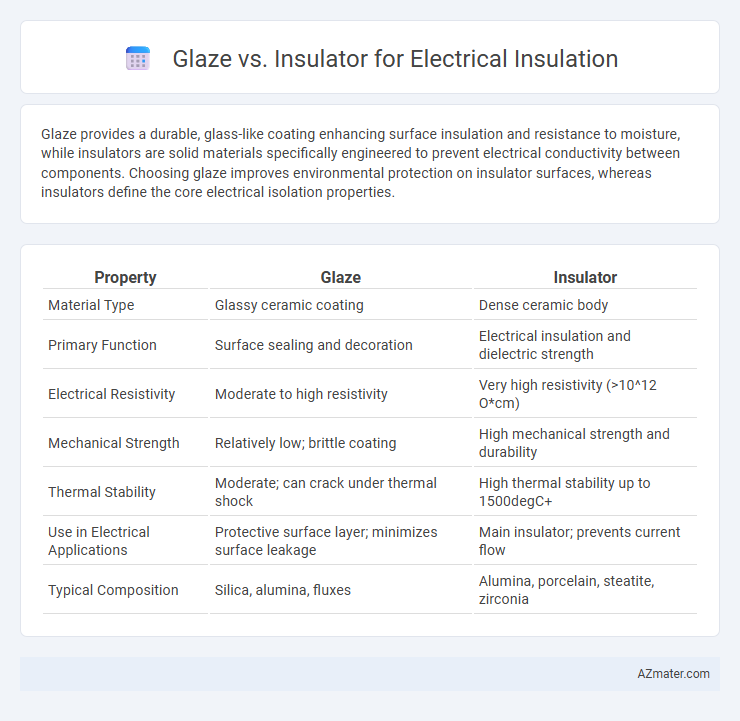Glaze provides a durable, glass-like coating enhancing surface insulation and resistance to moisture, while insulators are solid materials specifically engineered to prevent electrical conductivity between components. Choosing glaze improves environmental protection on insulator surfaces, whereas insulators define the core electrical isolation properties.
Table of Comparison
| Property | Glaze | Insulator |
|---|---|---|
| Material Type | Glassy ceramic coating | Dense ceramic body |
| Primary Function | Surface sealing and decoration | Electrical insulation and dielectric strength |
| Electrical Resistivity | Moderate to high resistivity | Very high resistivity (>10^12 O*cm) |
| Mechanical Strength | Relatively low; brittle coating | High mechanical strength and durability |
| Thermal Stability | Moderate; can crack under thermal shock | High thermal stability up to 1500degC+ |
| Use in Electrical Applications | Protective surface layer; minimizes surface leakage | Main insulator; prevents current flow |
| Typical Composition | Silica, alumina, fluxes | Alumina, porcelain, steatite, zirconia |
Introduction to Electrical Insulators
Electrical insulators prevent unwanted current flow by providing high resistance to electricity, essential for safeguarding circuits and equipment. Glaze coatings enhance the surface properties of insulators by increasing dielectric strength and protecting against environmental factors such as moisture and contamination. Insulators with glaze surfaces show improved durability, reduced electrical losses, and are commonly used in high-voltage applications for reliable insulation performance.
Overview of Glaze in Electrical Insulation
Glaze in electrical insulation serves as a protective coating applied to ceramic insulators, enhancing their resistance to environmental factors such as moisture, contamination, and electrical stress. This glassy layer improves surface smoothness and reduces leakage currents, thereby increasing the overall reliability and longevity of insulators in high-voltage applications. The chemical composition of the glaze, often rich in silicates and flux materials, determines its dielectric strength and thermal stability, making it essential for performance in electrical distribution and transmission systems.
Properties of Glaze Used in Insulators
Glaze used in electrical insulators features high dielectric strength, excellent thermal stability, and resistance to moisture and environmental contaminants, ensuring reliable insulation performance. Its smooth, glassy surface minimizes surface leakage currents and prevents contamination adherence, enhancing insulator longevity. The glaze's chemical inertness and mechanical hardness protect the ceramic core from mechanical damage and weathering effects.
Types of Materials Used as Insulators
Glaze insulators typically use ceramic materials coated with a glassy, vitreous layer that enhances moisture resistance and surface smoothness, improving electrical insulation properties. In contrast, insulators made from polymeric materials such as silicone rubber, ethylene propylene diene monomer (EPDM), and fiberglass-reinforced composites offer lightweight, hydrophobic surfaces that resist contamination and provide better performance in polluted environments. Both material types contribute to preventing electrical current leakage, but their selection depends on environmental conditions and mechanical requirements.
Glaze vs Base Insulator Material: Key Differences
Glaze coatings provide a smooth, glass-like surface that enhances weather resistance and electrical insulation properties, while base insulator materials such as porcelain or glass form the core structural component of electrical insulators. Glaze improves contamination resistance and reduces surface leakage currents, whereas the base insulator material determines mechanical strength and fundamental dielectric performance. Understanding the interaction between glaze and base insulator material is crucial for optimizing insulator longevity and efficiency in high-voltage applications.
Performance: Glaze-Coated vs Non-Glazed Insulators
Glaze-coated insulators exhibit superior performance due to their enhanced resistance to pollution and moisture, resulting in reduced surface conductivity and lower leakage currents. Non-glazed insulators, while easier to maintain, are more susceptible to dirt accumulation and surface degradation, which can compromise their insulating properties under harsh environmental conditions. The glaze layer acts as a protective barrier, significantly improving the insulator's durability and long-term reliability in electrical applications.
Advantages of Glazed Electrical Insulators
Glazed electrical insulators offer superior resistance to environmental elements such as moisture, dirt, and pollution, enhancing their durability and longevity in outdoor applications. Their smooth, glassy surface reduces surface conductivity, minimizing leakage currents and improving overall insulation performance. Glazed insulators also provide better mechanical strength and lower maintenance requirements compared to unglazed insulators, making them ideal for high-voltage power transmission.
Common Applications of Glazed and Unglazed Insulators
Glazed insulators, coated with a smooth ceramic or glassy finish, are commonly used in high-voltage power lines and electrical substations due to their superior resistance to weathering and pollution buildup. Unglazed insulators, featuring a rougher surface, find frequent application in distribution networks and low-voltage systems where mechanical strength is crucial but contamination resistance is less critical. Both types play essential roles in electrical insulation, optimizing performance based on environmental conditions and operational voltage levels.
Durability and Maintenance: Glaze vs Insulator Body
Glaze on electrical insulators offers a smooth, glass-like surface that enhances durability by resisting environmental pollutants and minimizing surface contamination, which reduces maintenance frequency. In contrast, the insulator body, often made from porcelain or polymer, provides structural strength but may require more maintenance due to its porous nature and vulnerability to cracks or erosion. The combination of a durable glazed surface with a robust insulator body optimizes overall performance and longevity in electrical insulation applications.
Conclusion: Choosing Between Glazed and Unglazed Insulators
Glazed insulators offer superior resistance to contamination, moisture, and environmental degradation due to their smooth, vitrified surface, making them ideal for harsh outdoor conditions. Unglazed insulators, while more cost-effective, typically require more maintenance and are less resistant to pollution and weathering. Selecting between glazed and unglazed insulators depends on balancing long-term durability needs and budget constraints for specific electrical insulation applications.

Infographic: Glaze vs Insulator for Electrical insulator
 azmater.com
azmater.com